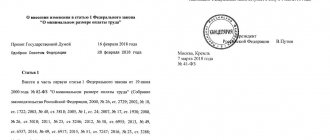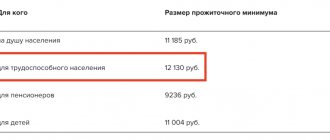Minimum wage and actual earnings
Before we figure out how to calculate the additional payment up to the minimum wage and who is entitled to such an additional payment, let’s find out the relationship between earnings and the minimum amount for remuneration.
Working citizens are guaranteed a minimum wage at the state level (Article 133 of the Labor Code). The minimum wage is established by Law No. 82-FZ of June 19, 2000 “On the minimum wage.” The basis for this payment is the employee’s fulfillment of working hours and job duties for the month. If earnings are less than the established amount, it must be brought up to the minimum wage.
The “minimum” salary is not a constant value and corresponds to the minimum subsistence level established for able-bodied Russians. From January 1, 2019, according to Law No. 82-FZ, the minimum wage is 11,280 rubles. Each region, subject of the Russian Federation, has the right to set its own limit, but not lower than the federal value.
How is the supplement to the minimum wage made in 2021? For correct calculations and payments, the organization first needs to think through the entire procedure in advance. What if the salary is less than the minimum wage? This is not considered a violation: the Labor Code allows for a situation where the official salary is set below the legal limit.
Earnings may be below the minimum wage. This is possible when working part-time for a month and when working part-time. In these cases, the salary is calculated based on the time worked, and payment up to the minimum wage for those working less than full-time is carried out proportionally, taking into account the actual working time.
In what cases can a salary be less than the minimum wage?
Employers often ask whether it is possible to pay wages less than the minimum wage. Under general conditions, the employee’s salary must be equal to or higher than the current minimum wage.
But in certain cases, a small remuneration rate is allowed. Let's take a closer look at these cases.
Part-time work
When establishing a minimum value, it is assumed that the employee must work the established standard duration per month.
In many organizations, employees are hired on a part-time or weekly basis. When an employment contract is drawn up, the rate is fixed in this agreement. Practice shows that it takes values of 0.25 bets, 0.5 bets, 0.75 bets, etc.
Employee has been working for less than a month
Very rarely there are situations when an employee joins an organization or leaves from the beginning of the month or at the end of this period. As a result, for an incomplete period of time, he may receive an accrued salary that is less than the current minimum wage.
The main condition in this case is that when recalculated for a full month, the remuneration value is greater than the current minimum value and that correct accounting of time worked is maintained.
There was downtime in production
Work situations at an enterprise can be very diverse. As a result, the organization may suspend its activities for a certain period.
If downtime at work occurs due to the fault of the employer or due to independent reasons, the latter must pay for this time based on 2/3 of the employee’s rate.
Salary deductions
Based on writs of execution or other documents, certain amounts may be withheld from the employee’s salary. As a result of such deductions, the employee may receive a salary significantly lower than the minimum wage.
However, such a situation cannot be considered a violation of the law if the initial accrual amount, before all deductions were made, was equal to or greater than the minimum wage.
Part-time work
If an employee works as a part-time worker, he does not have the right to work in a second place for more than 50% of the working time of work at the main place. At the same time, the law obliges him to establish a salary of no less than the minimum wage on the conditions of full compliance with the time norm.
Thus, his actual accrued payment may be less than the minimum wage, but it must be calculated based on the full salary of at least the minimum wage, taking into account the days or hours actually worked.
Being on sick leave or on vacation at your own expense
If an employee gets sick and takes sick leave, the employer actually does not pay him wages for the specified period. He is assigned compensation, which is calculated on the basis of average earnings for the previous 2 years. Its payment is made from the funds of the Social Insurance Fund.
However, the law establishes that the amount of average earnings for 1 month, calculated to compensate for sick leave, cannot be less than the established minimum wage.
Thus, if an employee was sick for part of the month, he will be paid a salary in proportion to the days worked, as well as compensation for sick leave.
Other cases
If work or services at an enterprise are provided on the basis of a concluded civil contract and not an employment contract (i.e. the individual is not a full-time employee), then the amount of payment can be any and does not depend on the current minimum wage.
The thing is that the conclusion and execution of a GPC agreement is regulated by the Civil Code, and not the Labor Code; the services provided within its framework are not labor activity between the employer and the subordinate, and therefore the provisions of the minimum wage do not apply to it.
When is it necessary to pay extra?
If a subordinate is paid less than the minimum wage, it is the employer’s responsibility to bring the salary up to the minimum wage. Let's look at how additional payments to the minimum wage are made in 2020:
- It is necessary to clarify the amount of the “minimum wage” established in the subject. If local authorities have not regulated a different limit for the region, you must be guided by the federal limit (currently 11,280 rubles).
- Determine the amount to be paid for the month, taking into account all charges: salary (tariff rate), bonuses and incentive payments, with the exception of the regional coefficient and compensation for work in a special climatic zone (Resolution of the Constitutional Court of December 7, 2021 No. 38-P)
- Compare accruals with the current minimum wage.
- Define the surcharge as the difference between the “minimum wage” and the accrual.
- Comparisons and additional payments (if necessary) are made every month.
It should be taken into account how such additional payment to the minimum wage is financed. How to pay extra correctly depends on the source of funds. State employees receive money from the authorities at the appropriate level, and commercial companies pay extra from their own funds.
How to bring your salary up to the minimum wage in 2021
Current legislation guarantees payment of wages in an amount not less than the current minimum wage to each employee of budgetary and commercial enterprises. This is stated in the text of paragraph 7 of Article 133 of the Labor Code of the Russian Federation. In this case, it is necessary to take into account some features:
- If we are talking about an employee of a company located in the Far North region (or in an area equivalent to it), the salary should not be lower than the minimum wage even before it is increased by the regional coefficient and additional payment for long work experience. That is, the salary of a worker in the Far North will always be higher than the minimum wage, taking into account the bonus and the regional coefficient.
- The salary should already include all amounts due to the employee (direct salary, various additional payments and allowances, compensation, bonuses) at the time of comparison with the minimum wage.
- The minimum wage is established not only at the federal, but also at the regional level by decision of the authorities of the constituent entity of the Russian Federation. Moreover, the regional (republican, regional, regional) minimum wage cannot be lower than the federal one.
Budgetary organizations
The earnings of employees at all budget levels must be no less than the “minimum wage”, and regional coefficients are calculated in addition to wages (Decision of the tripartite commission for the regulation of social and labor relations of December 25, 2018, protocol No. 12 “Unified recommendations... for 2021”). Funds are allocated by the budget of the appropriate level. In addition, extra-budgetary money and money received by the organization from business activities are also a source.
The peculiarity is that the location of an institution of federal significance does not matter. When financed from the federal budget, the minimum wage is applied based on the limit regulated at the federal level, that is, 11,280 rubles, and not on the amount approved for the subject where the organization is located.
When bringing wages to the minimum wage in budgetary institutions that are on the regional and local budget, the minimum established by the subject, taking into account the specifics of the area, will be applied. The calculation principle itself is similar to that stated above.
How to pay maternity benefits taking into account the new minimum wage
The labor and employment allowance (maternity benefits) must be counted from the minimum wage in two cases.
Case No. 1: insurance period is less than 6 months.
Let’s assume that the employee’s insurance coverage is less than 6 months. In this case, maternity leave for each month cannot exceed the minimum wage for that month. To avoid violating the restriction, proceed as follows:
- First, calculate the average daily earnings according to the general rules. If it turns out to be less than the minimum, consider it equal to the minimum. From 01/01/2020 – 398.794521 rub.
- then, for each month of maternity leave, calculate the maximum daily benefit by dividing the minimum wage by the number of days in the month. So, the maximum daily allowance, for example, in April 2021 is 404.33 rubles. (RUR 12,130/30 days), and in May 2021 – RUR 391.29. (RUB 12,130 / 31 days);
- then compare the average daily earnings with the maximum daily benefit and calculate the benefit for each month of vacation based on the lower amount.
An example of calculating maternity minimum wages in 2020.
Sokolova N.V. first hired on January 23, 2020. She goes on maternity leave for 140 days - from 07/01/2020 to 11/18/2020. The billing period in this case is 2021 and 2021, the insurance period at the start of the vacation is 5 months 9 days.
Since the employee did not have payments in the billing period, we consider the average daily earnings equal to the minimum - 398.794521 rubles. The maximum daily benefit in July and August 2021 is 391.29 rubles. (12,130 rubles / 31 days), in September, October and November - 404, 33 rubles. (RUB 12,130 / 30 days).
In July and August 2021, the average daily earnings (RUB 398.794521) are greater than the maximum daily benefit (RUB 391.29). Therefore, we calculate the benefit for these months from the maximum daily benefit - 24,259.98 rubles. (RUR 391.29 x 62 days).
In September, October and November 2021, the average daily earnings (398.794521 rubles) are less than the maximum daily benefit (404.33 rubles), so we calculate the benefits for these months from average earnings.
Benefit for the remaining 78 days of vacation (from September 1 to October 30 and from November 1 to November 18, 2010) - 31,105.97 rubles. (RUR 398.794521 x 78 days).
The benefit for the entire maternity leave will be 55,365.95 rubles. (RUR 24,259.98 + RUR 31,105.97).
Case No. 2: the insurance period is more than 6 months, but there is “not enough” earnings
The employee’s insurance experience is more than 6 months, but there were no payments during the billing period or the average daily earnings turned out to be less than the minimum (Part 1 of Article 14 of Law No. 255-FZ). Then calculate the benefit from the minimum daily earnings according to the general rules. The benefit for 140 days of maternity leave starting in 2021 is 55,831.23 rubles. (RUB 398.794521 x 140 days).
What to include in the calculation
According to Art. 133, 133.1 and 135 of the Labor Code, remuneration involves a rate or salary and various types of additional payments, including compensation for work in conditions different from the norm, bonuses and incentives. Accordingly, in a monthly calculation, an additional payment to an employee up to the minimum wage may consist of amounts additional to the salary (tariff). For example:
- bonus for length of service;
- bonus for qualifications and professionalism;
- bonuses;
- additional payment for night work;
- additional payment for work on holidays and days off.
It is important that the “minimum wage” includes holidays and weekends if the employee worked within working hours. If attracted beyond the standard time, the accrual is added to the minimum amount.
What is included in the minimum wage: payments and additional payments
Minimum wage according to Art. 129 of the Labor Code of the Russian Federation includes:
- salary according to the staffing table;
- compensation payments;
- incentive payments.
Compensation payments are compensation for some negative or difficult working conditions in which a person is forced to work. Such payments often include bonuses for harmfulness, unfavorable working conditions, secrecy, night work, etc.
Compensation payments of a permanent nature should be distinguished from one-time compensation. The latter are not included in the salary, and their purpose is to compensate for any costs incurred by a person while carrying out work.
Incentive payments are financial incentives for any positive results of a person’s work activity or achievements. Such payments often include bonuses for qualifications, length of service, academic degree, etc. The legislation does not contain a closed list of incentive payments, and therefore the employer can independently develop a list of them, securing it in local documentation. In addition, he can develop the procedure and conditions for calculating incentive payments under certain circumstances.
An employee may perform additional functions not stipulated by the employment contract. In this case, the employer must issue either an additional payment for the combination, which can be either a fixed amount or a percentage of the salary. Such a payment is outside the scope of the employment relationship, and therefore it is advisable not to take it into account in the calculation of wages, taking into account the minimum wage.
However, if the additional payment is directly related to the employee’s labor functions , for example, for working overtime or on a holiday, then this additional payment should be used when calculating wages taking into account the minimum wage. The Ministry of Labor also adheres to this position, having issued Letter No. 14-1/OOG-7353 dated 09/04/2018 for clarification.
How to pay the difference
It is not enough to know the correctness of the calculation and what the additional payment to the minimum wage in 2021 provides. How to pay extra correctly - it is important for the administration of the organization to resolve this issue. Options include:
- prepare orders monthly;
- sign an administrative document once, providing for a mandatory procedure every month: comparing the accrual with the “minimum wage” and determining the additional amount to be paid;
- Include a block on additional payment in local documents (regulations on the formation of the wage fund, collective agreement).
How to pay temporary disability benefits from the new minimum wage
Sickness benefits must be calculated from the minimum wage if the employee did not have earnings in the billing period or it is less than 24 times the minimum wage. For sick leave opened from 01/01/2020, this is 291,120 rubles. (RUB 12,130 x 24).
Calculate the average daily earnings from the minimum wage using the formula:
From 01/01/2020 it is equal to 398.794521 rubles. (RUB 12,130 x 24 / 730).
Otherwise, calculate the benefit as usual - multiply the average daily earnings by the percentage of payment and the number of sick days. Below we give a possible example of calculating sick leave from the new minimum wage.
An example of calculating sick leave from the minimum wage in 2020.
Suvorov A.B. first hired on December 3, 2019.
I was sick from 10/09/2020 to 10/18/2020. In 2021, he did not work at all, and his earnings for 2021 were 30,000 rubles, and his insurance period was 10 months.
Payments to Suvorov A.B. for the billing period (2018-2019) amount to 30,000 rubles. This is less than 24 times the minimum wage as of 10/09/2020 – RUB 291,120. rub. (RUB 12,130 x 24). Therefore, we calculate the average daily earnings from the minimum wage. It is equal to 398.794521 rubles. (RUB 12,130 x 24 / 730).
Insurance experience of Suvorov A.B. less than 5 years, so we calculate sick leave benefits at 60% of average earnings. The benefit for 10 days of illness will be 2392.77 rubles. (RUR 398.794521 x 60% x 10 days). From this amount:
- RUR 717.83 (398.794521 rub. x 60% x 3 days) – paid at the expense of the employer;
- the remaining amount (RUB 1,674.94) is paid from the Social Insurance Fund budget.
In an area with a regional coefficient, compare the employee’s earnings with the usual 24 times the minimum wage. But multiply the benefit itself, calculated from the minimum wage, by the regional coefficient (FSS Letter dated 03/11/2011 N 14-03-18/05-2129).
Making an order
There is no unified sample of an administrative document. The order is drawn up taking into account the specifics of document flow at a particular enterprise, but must contain:
- Name;
- date, place of signing;
- the basis for payment is the discrepancy between earnings and the minimum wage;
- personal information about the employee: full name, position, area of work (structural unit);
- amount to be paid;
- date of payment (simultaneously with earnings);
- indication of the officials responsible for the execution of the order;
- signature of the person issuing the order and the executors;
- date and signature of the employee receiving the amount regarding familiarization with the order.
Do not forget that the “minimum wage” is not constant; the minimum wage is revised annually. Therefore, from January of the next year, check its value.
The procedure for making additional payments to the minimum wage
Based on the provisions of Art. 133 of the Labor Code of the Russian Federation, calculation and issuance of additional payments up to the minimum wage are the responsibility of the employer. The head of the company can use the following methods of ensuring additional payment:
- adding the amount of additional funds to a bonus, financial assistance or any other payment due to a subordinate. This refers to any payment, the amount of which may vary based on the manager’s decision. Publication of additional documents is not required;
- drawing up a separate order from the manager.
It is important to note that there is no regulated form of the Order in question. Such paper should be drawn up in free form, however, taking into account the organization’s requirements for the preparation of official documents (indication of all details, the need for a seal and signature of the manager, etc.). Based on Federal Law No. 402 dated December 6, 2011. Official orders of the manager must contain:
Company name.- Document's name.
- Date of paper formation.
- Passport and professional information about the employee.
- Designation of the amount of additional payment up to the minimum wage, as well as the day of its issuance (often coincides with the day of payment of wages).
- The reason for issuing this document. The most common basis is Art. 133 of the Labor Code of the Russian Federation, or a reference to a regional agreement that regulates the level of the minimum wage in a specific federal subject.
- Designation of responsible employees for the execution of the order.
- Manager's signature and company stamp.
It may also be necessary to make adjustments to the employment agreement with a subordinate. So, based on Art. 57 of the Labor Code of the Russian Federation, the terms of remuneration for labor are essential aspects of the employment agreement. At the same time, based on Art. 72 of the Labor Code of the Russian Federation, if such aspects are adjusted, this must be documented.
Practice shows that drawing up additional agreements whenever it is necessary to issue an employee an additional payment up to the minimum wage is an unproductive operation. Therefore, the head of the company often includes a clause in advance in the Regulations on remuneration, according to which, if the final earnings are below the current minimum wage level, employees are entitled to additional funds. The specific amount of funds is calculated individually, depending on the amount of the employee’s salary and the current level of the minimum salary.
Salary below the minimum wage: responsibility
An employer does not have the right to pay full-time employees a salary below the minimum wage. For ignoring this rule, the labor inspectorate may punish the employer under paragraph 6 of Article 5.27 of the Code of Administrative Offenses of the Russian Federation. Fine for the manager - from 10,000 to 20,000 rubles; for organization - from 30,000 to 50,000 rubles.
For a repeated violation, the manager will pay from 20,000 to 30,000 rubles or will be disqualified for a period of one to three years. And the company itself will be fined in the amount of 50,000 to 100,000 rubles.
Minimum wage standards in Moscow and St. Petersburg
To date, regional minimum wages have been established that exceed federal ones in Moscow, St. Petersburg, Leningrad and Moscow regions.
They are established by regional agreements “On the minimum wage in the region.” All organizations operating in these subjects of the Federation are required to apply them. In all other regions, the standard is the federal minimum wage.
| The subject of the Russian Federation | Regional minimum wage | Establishing document |
| Moscow | 20 195 | Moscow tripartite agreement for 2019-2021 dated September 19, 2018. |
| Saint Petersburg | 19 000 | Regional agreement on the minimum wage in St. Petersburg for 2021 dated December 27, 2019 No. 343/19-C. |
| Moscow region | 15 000 | Agreement on the minimum wage in the Moscow region dated October 31, 2019 No. 243. |
| Leningrad region | 12 800 | Regional agreement on the minimum wage in the Leningrad region for 2021 dated November 28, 2019 No. 15/C-19. |
Who should be paid extra to the minimum wage?
If the staffing schedule or employment contract sets an employee’s pay below the minimum, then the organization is obliged to pay him an additional payment up to the established minimum wage. The amount is determined if the employee worked the entire month and fully complied with the standard working hours, as follows:
Let's look at an example of how to calculate an additional payment to the minimum wage if the month is not fully worked, but partially - in this case, an adjustment must be made for the actual time worked:
Bukashka Alexander Borisovich worked 18 days in May. He is given a five-day, 40-hour work week with a salary of 10,000 rubles. per month. No bonuses or allowances were paid in May. According to the schedule this month there are 20 working days.
Accrued to the employee:
10,000 / 20 × 18 = 9,000 rubles.
For actual time worked, based on the minimum wage:
12,130 / 20 × 18 = 10,917 rubles.
The additional payment to the minimum wage will be (regional minimum is not established):
10,917 - 9000 = 1917 rubles.
Additional payment to the minimum wage in a budgetary institution is carried out in a similar way. The legislation does not provide for any special features.









